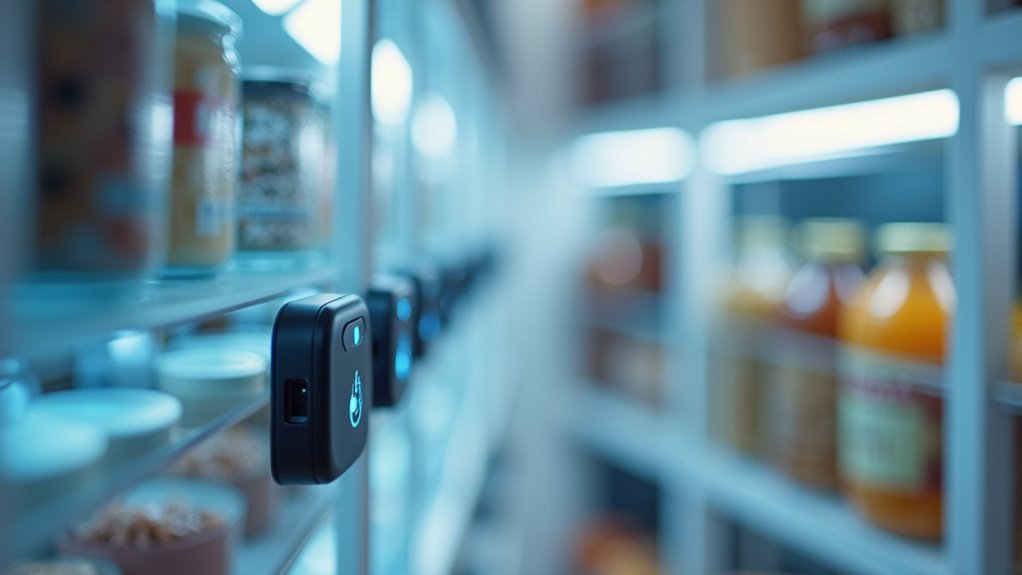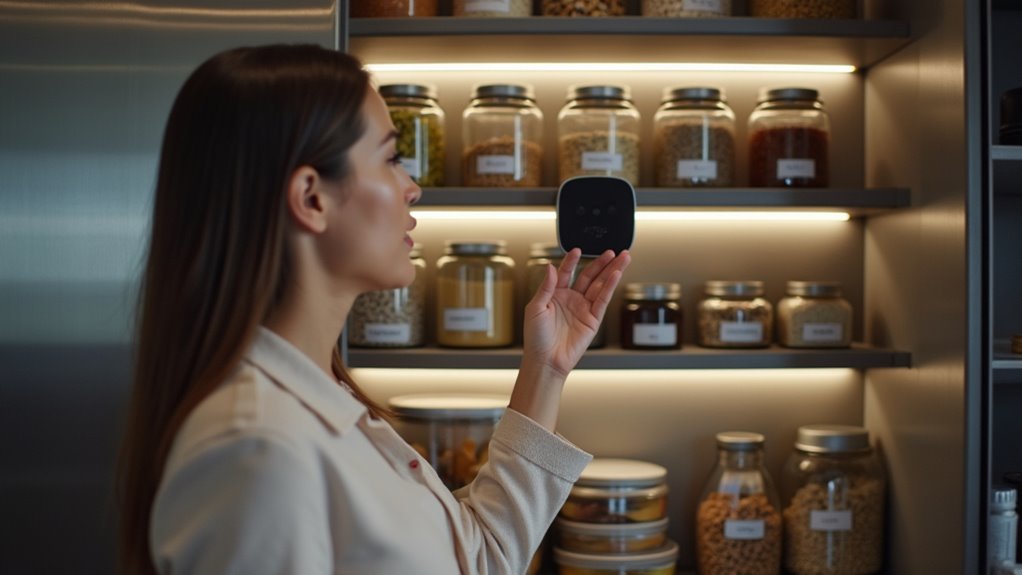You’ve probably wondered how smart pantry systems seamlessly track your groceries without constant manual input. The answer lies in a sophisticated network of interconnected technologies that work behind the scenes. IoT sensors, barcode scanning, and automated alerts form the backbone of these systems, but there’s more complexity beneath the surface than you might expect. Understanding these core components will reveal why some systems succeed where others fall short.
IoT Sensors: The Foundation of Smart Pantry Monitoring

While traditional pantry management relies on manual checks and guesswork, IoT sensors transform your kitchen storage into an intelligent monitoring system that tracks every item automatically.
These sensors use RFID technology and weight measurements to monitor your pantry’s contents without requiring your intervention, eliminating human error from your inventory management software processes.
You’ll receive real-time alerts when items run low or approach expiration dates, ensuring you never run out of essentials.
The sensors automatically trigger reorder requests when stock falls below your predetermined thresholds, maintaining consistent availability of necessary items.
Real-Time Stock Level Tracking and Alerts
You’ll experience continuous oversight of your pantry contents through live inventory monitoring that tracks every item in real-time.
Your system will instantly notify you when stock levels drop below your preset thresholds, eliminating guesswork and preventing unexpected shortages.
The integration of data analytics transforms this raw monitoring information into actionable insights that optimize your purchasing patterns and consumption habits.
Live Inventory Monitoring
As technology transforms modern kitchens, live inventory monitoring stands as one of the most practical innovations in smart pantry systems.
You’ll benefit from IoT technology that delivers real-time data about your stock levels, ensuring you’re always informed about what’s available in your pantry. The system sends alerts when items reach low levels or approach expiration dates, helping you prevent food waste through timely action.
You can manage everything remotely through mobile applications that send instant notifications to your smartphone.
Real-time data analytics reveal your consumption patterns, enabling better demand forecasting and smarter purchasing decisions. Automated reporting provides insights into inventory turnover rates, helping you maintain ideal stock levels while avoiding shortages or excess inventory buildup.
Automated Alert Systems
Building on that foundation of real-time monitoring, automated alert systems form the backbone of proactive pantry management by instantly notifying you when action is required.
These systems utilize sensors and real-time data to track stock levels, sending notifications directly to your mobile device when items run low or approach expiration dates.
You’ll reduce food waste considerably by receiving timely alerts that let you consume items before they spoil, minimizing losses from expired products.
The automated alert systems maintain ideal inventory levels, preventing stockouts of essential items needed for meal preparation.
This proactive approach improves your overall efficiency in managing food supplies, contributing to substantial cost savings and better sustainability practices through intelligent inventory management.
Data Analytics Integration
When data analytics integration powers your smart pantry system, you gain unprecedented insight into consumption patterns and inventory behaviors that transform how you manage food storage. This technology analyzes historical data to identify trends, optimize ordering schedules, and reduce food waste considerably.
Your system’s predictive analytics capabilities forecast future inventory needs using past sales data and market trends, ensuring stock levels consistently match demand. You’ll receive automated alerts when items approach expiration dates or fall below predetermined thresholds.
| Analytics Feature | Benefit |
|---|---|
| Historical Data Analysis | Identifies consumption patterns |
| Predictive Forecasting | Aligns stock with future demand |
| Threshold Monitoring | Prevents stockouts automatically |
| Expiration Tracking | Reduces food waste |
Data analytics integration enhances your inventory tracking precision, enabling proactive management that improves cost efficiency and operational effectiveness.
Barcode and QR Code Scanning Technology
You’ll streamline your pantry management by implementing barcode and QR code scanning technology that automates the entire inventory intake process.
This technology eliminates time-consuming manual data entry while drastically reducing the staff hours needed to track and update stock levels.
You can scan items in seconds rather than minutes, freeing up your team’s valuable time for other essential pantry operations.
Quick Inventory Intake Process
Since manual inventory entry consumes valuable time and introduces costly errors, barcode and QR code scanning technology transforms how you’ll manage your smart pantry’s intake process.
You’ll simply scan items as you add them, instantly capturing product details including expiration dates and nutritional information. This barcode and QR code scanning eliminates tedious manual data entry while providing immediate access to thorough product databases.
The system delivers real-time inventory updates the moment you scan each item. You’ll see accurate stock levels instantly, preventing duplicate purchases and ensuring ideal pantry management.
This streamlined approach minimizes human error considerably, creating reliable inventory records that support better restocking decisions. Your scanning process becomes effortless, maintaining precise stock visibility while reducing time spent on inventory management tasks.
Minimizing Resource Requirements
Beyond streamlining your inventory intake process, barcode and QR code scanning technology dramatically cuts the resources you’d typically need for pantry management.
You’ll slash the manpower required for manual stock tracking since scanning automates data entry and eliminates time-consuming manual counts. The technology prevents costly human errors that plague traditional inventory systems, reducing the need for correction procedures and additional oversight.
Your scanning system retrieves product information instantaneously, eliminating research time for expiration dates and specifications.
Integration with inventory management software enables real-time updates without manual intervention. Most importantly, streamlined replenishment processes support automated ordering, preventing both stockouts and excess inventory.
This optimization reduces operational costs while freeing up your valuable time and staff resources for other essential tasks.
Automated Expiration Date Management

When you’re managing a smart pantry, automated expiration date management transforms how you track perishable items by using sensors and barcode scanning technology to monitor shelf life in real-time.
You’ll receive mobile notifications when items approach their expiration dates, ensuring timely consumption and preventing spoilage. The system analyzes your usage patterns through machine learning algorithms, suggesting ideal consumption timelines based on your historical data.
These automated expiration dates greatly reduce food waste while cutting costs. Research shows restaurants alone could save up to $162 billion annually through automated inventory management.
Automated inventory management could save restaurants up to $162 billion annually by reducing food waste and cutting operational costs.
You’ll plan meals more efficiently as the system helps enhance your pantry management. By preventing spoilage and promoting strategic consumption, you’re not just saving money—you’re contributing to a more sustainable approach to food storage and usage.
Mobile App Integration for Remote Monitoring
You’ll gain unprecedented control over your pantry through mobile app integration that delivers real-time stock alerts whenever items run low or expire soon.
Your inventory data syncs seamlessly across cloud-based servers, ensuring you’re always working with the most current information regardless of when you last checked physically.
You can access and manage your pantry from multiple devices, letting family members update inventory from their phones while you’re creating shopping lists on your tablet.
Real-Time Stock Alerts
While traditional pantry management requires constant manual checking, smart pantry inventory systems revolutionize this process through mobile app integration that delivers real-time stock alerts directly to your smartphone.
These systems use sensors and cameras to automatically monitor inventory levels, sending immediate notifications when items run low or approach expiration dates.
Real-time data analytics enable these systems to provide timely alerts that help prevent food waste by encouraging you to consume perishables before they spoil.
You’ll receive instant notifications about your pantry status without manual intervention, thanks to seamless communication between smart shelves and IoT devices.
This remote monitoring capability empowers you to create shopping lists promptly and reorder items immediately, optimizing your inventory management while reducing stockouts.
Cloud-Based Data Sync
Cloud-based data synchronization transforms your smart pantry system into a truly connected experience, allowing you to access complete inventory information from anywhere through your mobile device. Your inventory database stays consistently updated across all connected devices, ensuring you’ll never miss critical stock levels or expiration dates.
| Feature | Benefit | Device Integration |
|---|---|---|
| Real-time updates | Instant inventory changes | Smart shelves, refrigerators |
| Remote monitoring | Access from anywhere | Mobile apps, tablets |
| Automatic notifications | Low stock alerts | Push notifications |
| Shopping list sync | Streamlined grocery ordering | All connected devices |
| Consumption analytics | Track usage patterns | Data dashboard |
This cloud-based data synchronization enables you to update shopping lists instantly, receive timely notifications about expiring items, and analyze consumption trends. You’ll make informed purchasing decisions while reducing food waste through enhanced meal planning efficiency.
Multi-Device Access Control
Mobile app integration extends your smart pantry’s capabilities beyond the kitchen, enabling seamless control and monitoring from virtually any location. You’ll receive instant alerts when pantry inventory runs low or items approach expiration dates, helping you minimize food waste and make smarter purchasing decisions.
Whether you’re using your smartphone at work or tablet while traveling, you can access real-time stock levels and manage your food supplies effortlessly.
Smart pantries with mobile integration offer automated grocery lists and recipe suggestions based on available ingredients, streamlining your meal planning process.
Advanced apps synchronize with other smart kitchen devices, creating a unified food management system. This multi-device accessibility guarantees you’re always connected to your pantry’s status, eliminating last-minute shopping trips and optimizing your overall kitchen efficiency.
Smart Scale Technology for Weight-Based Tracking
As consumer demand for precision in food management grows, smart scale technology has emerged as a cornerstone of modern pantry inventory systems. You’ll find these weight-based tracking devices seamlessly integrate with your existing smart inventory software, automatically updating quantities as you remove or add items.
| Feature | Benefit |
|---|---|
| Real-time weight monitoring | Prevents stockouts and overstocking |
| Wi-Fi/Bluetooth connectivity | Mobile app synchronization and alerts |
| Automated data transfer | Enhanced operational efficiency |
| Historical pattern analysis | Optimized ordering schedules |
When you implement smart scales in your food inventory management, you’re gaining precise portion control that minimizes waste and improves cost management. These advanced systems analyze consumption patterns over time, helping you optimize turnover rates and make data-driven decisions about your pantry operations.
Voice-Activated Inventory Control Systems

Voice commands transform how you interact with your pantry inventory, eliminating the friction of manual data entry while cooking or meal planning.
You’ll simply tell Alexa or Google Assistant what you’ve added or used, and the AI processes your requests instantly. The system provides real-time updates on what’s stored on your smart shelves without requiring you to physically check items.
You can ask about expiration dates and nutritional information to optimize meal planning and reduce waste. The inventory software automatically generates shopping lists when items run low or approach expiration dates.
Voice integration with other smart appliances creates seamless pantry management, letting you update inventory while your hands are busy cooking or cleaning.
Machine Learning Algorithms for Usage Prediction
You’ll need robust data collection methods to gather extensive consumption patterns from your smart pantry sensors and user interactions.
Training predictive algorithms requires feeding this historical data into machine learning models that can identify seasonal trends, frequency patterns, and usage correlations across different food categories.
Once deployed, these systems continuously refine their accuracy through real-time pattern recognition, adapting to your changing habits and automatically adjusting inventory predictions.
Data Collection Methods
Machine learning algorithms transform raw pantry data into actionable insights by continuously analyzing your consumption patterns and predicting future needs.
Your smart pantry employs sophisticated data collection methods to gather information from multiple sources. Inventory sensors track real-time stock levels while monitoring your interactions with stored items. These systems record your purchasing history, dietary preferences, and consumption rates to build extensive user profiles.
The data collection methods also capture temporal patterns, identifying seasonal trends and changing behaviors over time. Your smart pantry processes expiration dates, recipe usage, and meal planning data to enhance prediction accuracy.
This continuous data gathering enables machine learning models to refine their algorithms, delivering increasingly precise recommendations for grocery lists, recipe suggestions, and waste reduction strategies tailored to your household’s unique consumption patterns.
Predictive Algorithm Training
While your smart pantry collects vast amounts of data, predictive algorithm training transforms this information into reliable forecasting models that anticipate your household’s inventory needs.
These machine learning algorithms analyze your historical usage patterns, identifying when you typically consume specific items and how much you use. The training process involves feeding consumption data, seasonal variations, and purchasing trends into the system, enabling it to recognize patterns unique to your household.
As the algorithms receive more data over time, they continuously refine their accuracy. This adaptive learning capability means your inventory management becomes increasingly precise, reducing food waste and preventing stockouts.
The trained models can even detect anomalies in your consumption patterns, alerting you to potential spoilage risks or unusual usage drops for specific products.
Real-Time Pattern Recognition
As your smart pantry operates throughout the day, real-time pattern recognition algorithms continuously monitor and analyze every interaction with your inventory.
These machine learning systems examine your past purchasing behavior and seasonal demand fluctuations to predict future consumption trends with remarkable accuracy. Your system’s real-time data analytics capabilities enable it to enhance inventory levels, preventing costly overstocking or frustrating stockouts.
The algorithms adapt dynamically as new data flows in, reflecting your changing preferences and behaviors.
This sophisticated inventory management approach can reduce food waste by up to 25% by forecasting when perishables will expire and prompting timely usage. Enhanced predictive capabilities also power automated ordering features, ensuring your stock levels stay efficient and aligned with your actual demand patterns.
Cloud-Based Data Storage and Synchronization
When you store your smart pantry data in the cloud, you’re accessing a powerful foundation that transforms how inventory management works across your entire household.
This cloud-based data storage guarantees real-time synchronization across all your devices, giving you instant access to current pantry contents whether you’re at home or grocery shopping.
You’ll benefit from seamless integration with smart kitchen appliances that automatically update your inventory and send expiration alerts.
The system analyzes your historical usage patterns to predict future needs, preventing over-purchasing and waste. Family members can collaborate effortlessly, viewing and managing inventory together for better meal planning.
Advanced security features like encryption and multi-factor authentication protect your data from unauthorized access while maintaining convenience.
Integration With Smart Refrigerators and Appliances
Building on this cloud foundation, your smart refrigerator becomes the central hub that connects all your kitchen appliances into one unified inventory management system.
AI-powered cameras automatically scan and identify products, updating your inventory while providing expiration alerts to prevent waste. You’ll receive real-time notifications on your mobile app, allowing remote monitoring of pantry contents and automatic shopping list generation based on consumption patterns.
Your smart appliances communicate seamlessly with each other, notifying connected devices when items run low.
Barcode scanning technology provides instant access to nutritional data and expiration dates, enhancing meal planning decisions.
Through IoT integration, your smart refrigerators can trigger automated reordering when stock levels drop below predetermined thresholds, ensuring you’ll never run out of essentials again.
Automated Reordering and Shopping List Generation
Once your smart pantry system identifies low inventory levels, automated reordering springs into action, transforming how you maintain household supplies.
Your system generates purchase orders using real-time inventory data, preventing shortages and ensuring essential items remain stocked. You’ll receive intelligent shopping lists based on current pantry contents and your preferences, streamlining grocery trips while reducing waste.
The system’s predictive analytics anticipate your future needs by analyzing historical consumption patterns, improving reordering accuracy over time.
You can integrate directly with online shopping platforms, enabling seamless ordering from suppliers without manual intervention. Additionally, you’ll get notifications when items approach expiration dates, prompting timely usage or replacement.
This thorough approach saves you time, reduces food waste, and maintains peak pantry efficiency through intelligent automation.
Temperature and Environmental Monitoring
Temperature and humidity fluctuations can destroy your carefully stocked pantry items in mere hours, making environmental monitoring a critical component of any smart inventory system.
Environmental monitoring isn’t optional—it’s the critical defense system protecting your pantry investment from temperature and humidity disasters.
You’ll benefit from sensors that continuously track these conditions, ensuring ideal storage environments that greatly extend your food’s shelf life.
When temperature variations occur, you’ll receive instant alerts enabling quick interventions before spoilage happens. The monitoring system integrates with AI algorithms that analyze data patterns, helping you adjust storage practices based on real-time conditions.
This consistent oversight reduces spoilage rates dramatically, contributing to lower food waste and enhanced sustainability.
You’ll save money by minimizing frequent restocking due to spoilage, while improving your overall inventory management efficiency through proactive environmental control.
Multi-Device Connectivity and Home Network Integration
While environmental sensors protect your stored goods, your smart pantry’s true power emerges when it connects seamlessly across all your devices and integrates with your home network.
Multi-device connectivity lets you manage pantry contents from smartphones, tablets, and smart assistants, ensuring everyone stays synchronized. Your smart shelves communicate with refrigerators and inventory apps through home network integration, delivering instant alerts about low stock or expiring items.
IoT technology connects your pantry with other kitchen appliances, automatically updating inventory and suggesting recipes based on available ingredients.
Voice-activated controls through smart assistants let you check levels, add shopping items, and receive notifications hands-free. This collaborative system allows family members to access and update information together, creating an organized, efficient kitchen management experience.
Cost Analysis and Budget Management Features
Beyond convenience and organization, smart pantry systems deliver measurable financial benefits through sophisticated cost analysis and budget management features.
These systems transform how you track expenses and enhance spending decisions.
You’ll gain powerful insights through:
- Real-time data analytics that track inventory levels and ordering patterns for smarter purchasing decisions
- Automated ordering features that maintain ideal stock levels while preventing costly shortages and surplus waste
- Predictive analytics that forecast demand accurately, minimizing over-purchasing and budget overruns
- Detailed reporting on inventory turnover rates and spoilage risks to focus spending on high-demand items
- Significant reduction in food waste costs, helping you save from the $162 billion lost annually to waste
These cost analysis and budget management capabilities guarantee you’re making data-driven decisions that maximize your pantry investment.
Frequently Asked Questions
How Do You Keep Track of Pantry Inventory?
You can track pantry inventory by manually listing items, using smartphone apps with barcode scanning, checking expiration dates regularly, or installing smart sensors that automatically monitor stock levels and send notifications.
What Should Not Be Stored in a Pantry?
You shouldn’t store perishable items like dairy, fresh meat, or most produce in your pantry. Don’t keep damaged canned goods, heat-sensitive chocolate, or improperly sealed grains that’ll attract pests.
Is There a Pantry Inventory App?
You’ll find several pantry inventory apps available that use barcode scanning, expiration tracking, and meal planning features. They help you reduce food waste and manage stock levels efficiently through automated alerts.
What Is the Most Important Thing to Keep in Your Pantry?
You’ll want staple ingredients like rice, pasta, and canned goods as your pantry’s foundation. They’ve got long shelf lives, form meal bases, and won’t spoil quickly, ensuring you’re always prepared.





Leave a Reply